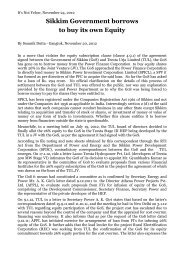Socio-Cultural Environment - Affected Citizens of Teesta (ACT)
Socio-Cultural Environment - Affected Citizens of Teesta (ACT)
Socio-Cultural Environment - Affected Citizens of Teesta (ACT)
Create successful ePaper yourself
Turn your PDF publications into a flip-book with our unique Google optimized e-Paper software.
10<br />
CISMHE<br />
most <strong>of</strong> the Lepcha families have blood relation with either Bhutia or<br />
Tibetan or the Nepalese.<br />
The ethnic Bhutias <strong>of</strong> Sikkim are a dominant race, both physically<br />
and spiritually. The Bhutias belong to the Tibeto-Burman stock and are<br />
fair complexioned, tall and robust. They imported from north a distinctly<br />
“Tibetan culture, Tibetan language, Lamaistic Buddhism, and a<br />
combination <strong>of</strong> pastoralism and semi-settled agricultural pattern” (A.C.<br />
Sinha, 1975). The Tibetan traders, farmers and the lamas are said to<br />
have visited this land since tenth or eleventh century. At that time the<br />
country was very sparsely populated and was inhabited by the primitive<br />
Lepcha and Limbu tribes. The pre-existing tribes were mostly<br />
concentrated in the humid forests and river valley areas leaving vast<br />
stretches <strong>of</strong> highland meadows empty. On the other hand, the Tibetan<br />
pastorals found the Alpine grasslands in the upper reaches <strong>of</strong> the<br />
Himalayas most suitable for their yak and sheep herds and started to set<br />
up semi-permanent villages in the heart <strong>of</strong> grasslands <strong>of</strong> North Sikkim.<br />
The Bhutias, though not very skilled in crop farming, gradually started<br />
cultivating and inhabiting the lower valleys. The wandering habits they<br />
inherited from their pastoral and trading ancestors made them down to<br />
earth and tactical in their dealings with others. Taming <strong>of</strong> animals as well<br />
as trading <strong>of</strong> merchandise came easily to them and they did not take<br />
much time to naturalize themselves on the new soil <strong>of</strong><br />
Demazong/Denzong (valley <strong>of</strong> rice), i.e. Sikkim. The mendicant lamas <strong>of</strong><br />
Tibet, especially those <strong>of</strong> old non-reformist school, too found a safe<br />
haven in Sikkim. It is believed that a group <strong>of</strong> lamas initiated the Bhutia




